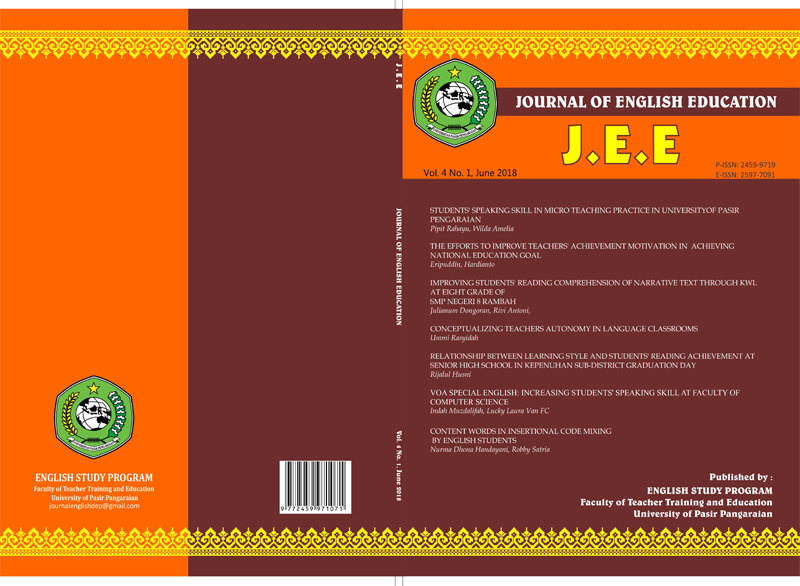VOA Special English: Increasing Students’ Speaking Skill at Faculty of Computer Science
Keywords:
VOA, Special English, Increasing Students’ Speaking Skill.Abstract
English is a Foreign Language as a subject that has been studying since elementary level. However, there were found minimal skill competence of speaking in Engish. Thus, it needs improvement both from the media system used and the appropriate strategy for the English course as a general basic course in particular in the Faculty of Computer Science. Technology can be an alternative as the media in education prosess. One of these media is Voice of America Special English Education Report. Basicaly, there are several benefits of using this media such as listening; while they are listening VOA automatically they are studying how to pronounce something; another skill is reading and writing skill because this media supported by running text. Thus, automatically this media includes four language skill in English. The subject of this research is Computer science students second semester. The purpose of this research is to find out whether the use of VOA Special English Education report can improve students’ speaking skill in English. The data was collected by applying the speaking test which used rubric scoring. The method of this research is classroom action research. There were two cycles of the test as comparative the improvement of students’ speaking skill in using VOA Special English Education Report . The result of this research that there is significant improvment of using VOA Special English Education Report. The score of the first cycle is 56,8 and the second cyce is 64,8. It means that there is increasing of the score speaking test by using the media VOA Special Engilsh Education Report.References
Braxton, J. M., Jones, W. A., Hirschy, A. S., & Hartley III, H. V. (2008). The role of active learning in college students’ persistence. New Directions for Teaching and Learning, 20(115), 71- 83.
Bashir,Marriam. (2011) Factor Effecting Students’ English Speaking Skills. British Journal of Arts and Social Sciences. ISSN: 2046 – 9578, Vol.2 No 1(2011)
Bingol, Mustafa Azzem. (2014). Listening Comprehension Difficulties Encountered by Students in Second Language Learning Class. Journal of Educationan Instructional Studies in the World. 2014, Vol.4 ISSN: 2146 - 7463
DeBourgh, G. A. (2008). Use of “clickers” to promote acquisition of advanced reasoning skills Nurse education in Practice, 8(2), 76-87.
Felder, R.M. & Brent, R. (2009). Active learning: An introduction. ASQ Higher Education Brief, 2(4). Retrieved November 11, 2012, from http://www4.ncsu.edu/unity/lockers/users/f/felder/public/Papers/ALpaper(ASQ).pdf
Hermawan, A. Herry, Zaman, B. Riayana, C. (2007). Media Pembelajaran Sekolah Dasar. Bandung: UPI Press
Hoffman, C., & Goodwin, S. (2006). Clickers in the classroom: Is that your final answer? Public Services Quarterly, 3, 264-267.
Huffman, S. (2011). Using mobile technologies for synchronous CMC to develop L2 oral proficiency. In. J. Levis & K. LeVelle (Eds.), Proceedings of the 2nd Pronunciation in Second Language Learning and Teaching Conference (pp. 122-129). Ames, IA: Iowa State University.
Hughes, Arthur. 2003. Testing for Language Teacher. Great Britain: Cambridge University Press
Kusni, 2010. Modul Classroom Action Research. PPG Bahasa Inggris. Padang: UNP Press
Kemmis, Stephen and Robin Mc Taggart (Ed) 1998. The Action Research Planner (3rded) Victoria: Deakin University
Lantz, M. E. (2010). The use of clickers in the classroom: Teaching innovation or merely an amusing novelty? Computers in Human Behavior, 26, 556–561.
Lea, B. (2008). Clickers adoption in a small class setting. Decision Line, 39(4), 7 – 11.
Linse. (2005). Practical English Language Teaching: Young Learner. New York: Mc Graw – Hill ESL/ELT
Luoma, S. (2009). Assessing Speaking. Cambridge: Cambridge University Press
Motteram,Garry. (2013). Innovation in Learning Technology for English language Teaching. British Council 2013 Brand and Design/C607 ISBN 978 – 0- 86355 – 713-2
Nation, I.S.P. & Newton, J. (2009). Teaching ESL/EFL Listening and Speaking. New York: Routledge
Nguyen, T., & Trimarchi, A. (2010). Active learning in introductory economics: Do econlab and alpha make any difference? International Journal for the Scholarship of Teaching and Learning, 4(1), 1–18.
Qinghong, M. A. (2009). Key elements in conducting communicative approach to language teaching. Canadian Social Science, 5(2), 46-55.
Rost, M. (2011). Teaching and Researching Listening. London: Pearson Education Limited
Tabbers, H. K., & de Koeijer, B. (2010). Learner control in animated multimedia instruction. Instructional Science, 38, 441-453.
Thurnbury,Scot. (2009). How to Teach Speaking. London: Cambridge
Wu, X., & Gao, Y. (2011). Applying the extended technology acceptance model to the use of clickers in student learning: Some evidence from microeconomics classes. American Journal of Business Education, 4(7), 43 – 50.
Yasin, Anas. (2011). Penelitian Tindakan Kelas: Tuntutan Praktis. Padang: Bung Hatta University Press.




